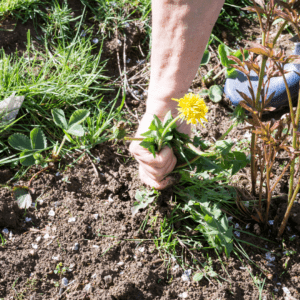Winter is here! Well, technically winter starts December 21st, but that’s just days away. So it’s time to start thinking about Spring! North Florida spring yard clean-up actually starts in the winter. The cooler temperatures of the winter months make it the perfect time to get your lawn ready for the spring season. It starts with some simple steps you can take that will make your spring lawn care easier and more efficient. So let’s get right to it, here are our top four spring lawn care preparation tips!
First, start by pruning hedges, trees, and vines
Any dead branch in your hedges or trees runs the risk of falling this winter if it’s not properly removed. And while tall tree trimming isn’t something most homeowners are equipped to handle, pruning hedges and smaller trees is relatively easy. In addition, overgrowth within your hedges and trees can actually hurt their overall health. It’s better to selectively prune them now, in the winter, than to deal with larger issues later in the spring.
Most tree care experts will also tell you that cooler weather is the optimal time to prune and trim larger, older trees on your property. Winter lawn care works to their advantage as the tree is less stressed and less likely to develop any issues from cooler weather lawn care.
Finally, some people love vines. They can add an air of distinction to an older home or create a unique look around a fence. However, vines can quickly get out of control if not properly pruned or tended to. Now is the best time to trim them back so that you don’t have significant overgrowth in the spring.
Second, it’s time for some weed removal
Any organic waste that falls into your flower or garden beds while pruning hedges and trees should be removed. While you’re already working in them, now is the best time for weed removal in those same areas. After all, it’s more efficient to kill two birds with one stone — don’t make any unnecessary work for yourself!
Remove all leaves, wood (such as smaller branches or wood chips from your pruning efforts), and most importantly, weeds from your landscaping beds. By keeping your beds cleared of this unnecessary thatch, you’re promoting healthier flower and plant growth in the spring.
Weed removal can be a tedious process in and of itself. Weeds left to grow exponentially can be downright frustrating to pull up. Try to get as close to the base of the weed as possible. In some cases, we’ve even seen homeowners who have had to trim weeds using hedge clippers — that’s some serious unattended lawn care! Be aware of how much soil you’re pulling up with weed removal, and be prepared to replace topsoil as necessary.
Third, rake and add mulch where needed
After you’re finished with weed removal, your next step is adding more mulch in flower beds, around your foundation, and around trees where it needs to be replaced.
Start by raking the existing mulch to gauge how much of it is still useable and how much of it needs to be replaced. While working on weed removal or clearing debris from your flower and garden beds, you may inadvertently lose some of your mulch during cleanup. Most mulches are colored to match the property’s aesthetic. This can fade over time due to the sun’s effect on your mulch, and you may discover that it’s necessary to replace all of it in certain areas (especially in or around areas with minimal shade). Most likely, this will occur more around the trees in your yard and less around your hedges.
Why replace mulch in the first place? Well, as it turns out mulch helps to prevent soil erosion. It can also suppress weeds, reducing the amount of time you spend in the yard taking care of that task. Mulch comes in various varieties, including organic materials such as pine needles or mulched leaves as well as traditional chipped wood. If you’ve never taken the time to add mulch to your landscaping, do it now! It is the perfect time to add some and make your spring lawn care much easier!
Finally, aerate your lawn
In the past, we’ve talked about thatch and how to deal with it. Thatch can be a major headache for homeowners. It’s essentially a dead layer of organic material ranging from leaves to grass clippings to dead bugs and more. Removing thatch is critically necessary to having a healthy lawn. No spring lawn care preparation is complete without getting rid of this layer of rot.
Rake your lawn to pull up the thatch. This will have the added benefit of aerating your lawn by loosening compacted soil from summer activities (yard games, repeated mowings, animal traffic, etc). Aeration can help stop rainwater from pooling while also allowing nutrients to penetrate deeper into the soil itself. Once the Alachua county fertilizer ban is lifted, feed your lawn after aeration by spreading a non-toxic, high-phosphorus fertilizer that promotes yard health (and be sure to keep an eye on our future blogs for updates on when we’re allowed to resume this step!)
Landscaping in the spring is easy if you start prep in the winter
Cool-weather yard clean-up is much easier than tackling your lawn in the humid North Florida spring and summer. By taking some proactive steps today — such as trimming, removing weeds, adding mulch, as well as aerating and feeding your lawn — you’ll save yourself extensive headaches and unnecessary labor in the spring. In this case, an ounce of prevention is worth more than a pound of cure!
One more thought: if you’re still wondering what to do to prepare your lawn for spring, we have the solution for you! One of the best things you could do is to contact Sun Power Lawn Care! We’ll sit down and discuss which of our package options is best for your lawn needs. Contact us today and a member of our team will be in touch to set up your appointment!
Here are some great resources to help your lawn looks its best:



